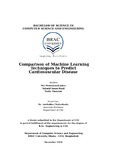| dc.contributor.advisor | Chakrabarty, Amitabha | |
| dc.contributor.author | Jaber, Mir Mohammad | |
| dc.contributor.author | Raad, Tahmid Imam | |
| dc.contributor.author | Tasneem, Tasfia | |
| dc.date.accessioned | 2019-02-13T06:56:55Z | |
| dc.date.available | 2019-02-13T06:56:55Z | |
| dc.date.copyright | 2018 | |
| dc.date.issued | 2018-12 | |
| dc.identifier.other | ID 15101091 | |
| dc.identifier.other | ID 17301219 | |
| dc.identifier.other | ID 15301083 | |
| dc.identifier.uri | http://hdl.handle.net/10361/11408 | |
| dc.description | This thesis is submitted in partial fulfilment of the requirements for the degree of Bachelor of Science in Computer Science and Engineering, 2018. | en_US |
| dc.description | Includes bibliographical references (page 36). | |
| dc.description | Cataloged from PDF version of thesis. | |
| dc.description.abstract | The purpose of this thesis is to examine and compare the accuracy of different
data mining classication systems through different machine learning techniques
to predict cardiovascular disease. This comparison shows the different accuracy
rates of different techniques and reasons behind their variations. The Cleveland
dataset for heart diseases has been used in this study which contains 303
instances. The data has been divided into two sections named as training and testing
datasets. The 10- fold Cross Validation has been used here in order to work
with the expanded dataset. The k-Nearest Neighbors, Support Vector Machine,
Decision Tree, Random Forest, Gaussian Naive Bayes, Logistic Regression and
Deep Belief Network machine learning techniques have been investigated in this
research. Besides, ensemble learning method voting classifier has been applied
on the data set. By the end of the implementation part, we have found Gaussian
Naive Bayes is giving the maximum accuracy in our dataset and deep belief
network is performing very poor. The reasons of variations of these different
techniques by analyzing their characteristics and behavior with respect to the
dataset has been understood by the study conducted for this thesis. | en_US |
| dc.description.statementofresponsibility | Mir Mohammad Jaber | |
| dc.description.statementofresponsibility | Tahmid Imam Raad | |
| dc.description.statementofresponsibility | Tasfia Tasneem | |
| dc.format.extent | 36 pages | |
| dc.language.iso | en | en_US |
| dc.publisher | BRAC University | en_US |
| dc.rights | BRAC University theses are protected by copyright. They may be viewed from this source for any purpose, but reproduction or distribution in any format is prohibited without written permission. | |
| dc.subject | Machine learning | en_US |
| dc.subject | Cardiovascular diseases | en_US |
| dc.subject.lcsh | Diseases -- Early detection. | |
| dc.subject.lcsh | Stroke; etiology | |
| dc.subject.lcsh | Medical informatics. | |
| dc.subject.lcsh | Artificial intelligence. | |
| dc.subject.lcsh | Machine learning. | |
| dc.title | Comparison of machine learning techniques to predict cardiovascular disease | en_US |
| dc.type | Thesis | en_US |
| dc.contributor.department | Department of Computer Science and Engineering, BRAC University | |
| dc.description.degree | B. Computer Science and Engineering | |

